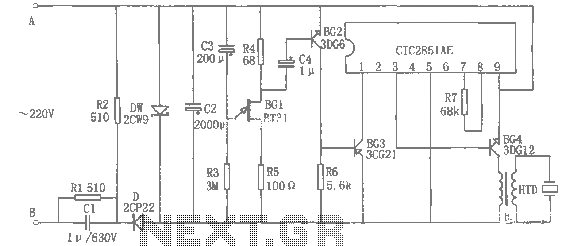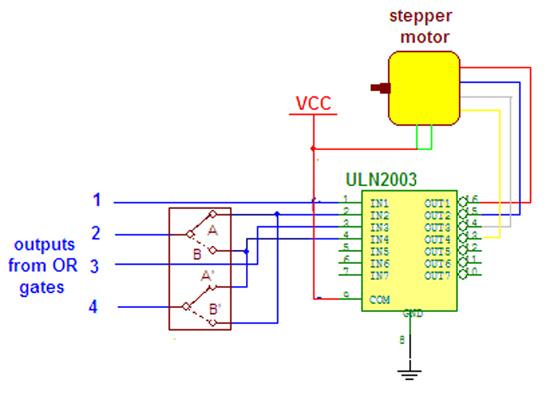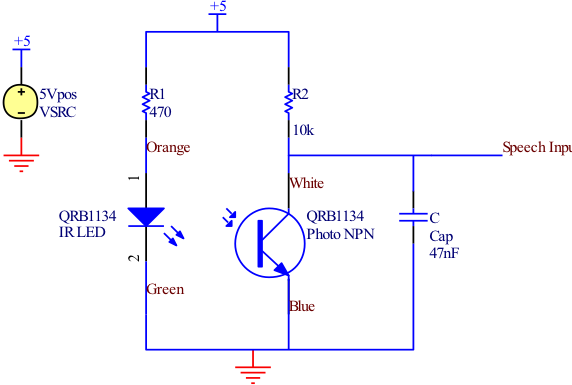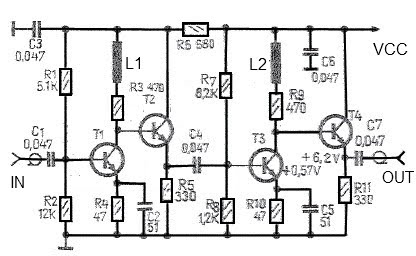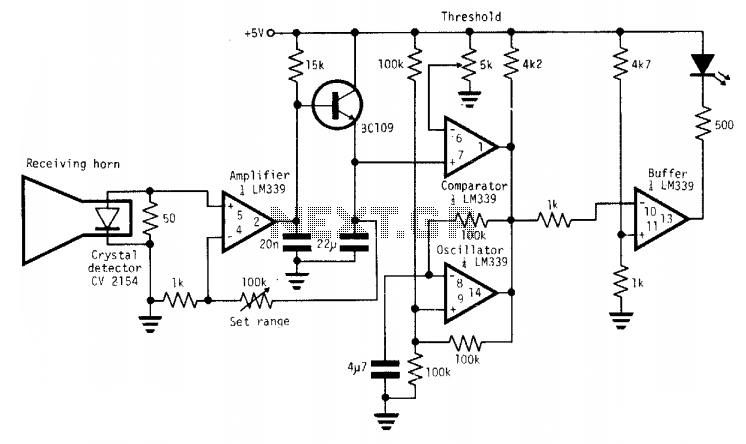
555 Tester circuit
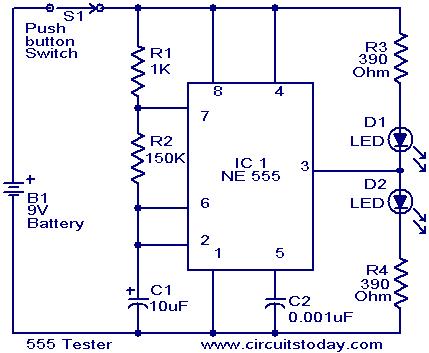
The NE555 timer is configured as an astable multivibrator. When the push button switch S1 is pressed, the LEDs D1 and D2 will flash alternately. When the output is high, D2 will illuminate, and when the output is low, D1 will illuminate. The flashing rate is determined by the resistor values R1, R2, and the capacitor C1. Upon pressing the push button S1, C1 begins to charge through R1 and R2. As the voltage across C1 increases beyond two-thirds of the supply voltage, the internal flip-flop toggles. Consequently, pin 7 goes low, and C1 starts discharging. When the voltage across C1 drops below one-third of the supply voltage, the internal flip-flop resets, causing pin 7 to go high again, and C1 begins charging anew. This cycle continues as long as the integrated circuit (IC) is functioning correctly.
The NE555 timer in astable mode operates continuously, producing a square wave output without requiring any external triggering. The configuration involves connecting the discharge pin (pin 7) to a resistor network composed of R1 and R2, which sets the timing intervals for the charging and discharging phases of the timing capacitor, C1. The values of R1 and R2, along with the capacitance of C1, can be calculated using the formula for the frequency of oscillation:
\[ f = \frac{1.44}{(R1 + 2R2) \cdot C1} \]
This frequency determines how fast the LEDs will flash. The duty cycle, which indicates the proportion of time the output is high compared to the total period, can also be adjusted by varying R1 and R2.
The push button switch S1 serves as a manual trigger for the circuit, initiating the oscillation process. When pressed, it allows C1 to charge, and the subsequent voltage levels at the threshold and trigger pins (pins 6 and 2, respectively) dictate the operation of the flip-flop inside the NE555. The LED indicators D1 and D2 provide a visual representation of the output state, allowing for easy observation of the circuit's operation.
The design ensures that the circuit will function correctly as long as the NE555 timer is operational, with the timing components (R1, R2, C1) selected to achieve the desired flashing rate and duration. Proper selection of these components is crucial for achieving the intended performance of the circuit.Here the NE555 is wired as an astable multivibrator. When the push button switch S1 is pressed the LEDs D1 & D2 will flash alternatively. That is when output is high D2 will glow & when output is low D3 will glow. The rate of flashing will depend on components R1, R2 & C1. When push button S1 is pressed, C1 will start charging through R1&R2. When the voltage across C1 rises above 2 of 3 is the supply voltage the internal Flip Flop toggles. The pin 7 becomes low & C1 starts discharging. When the voltage across C1 goes below 1of 3 of supply voltage the internal Flip Flop resets & pin7 goes high. The C1 again starts charging. All this will take place if the IC is healthy. 🔗 External reference
The NE555 timer in astable mode operates continuously, producing a square wave output without requiring any external triggering. The configuration involves connecting the discharge pin (pin 7) to a resistor network composed of R1 and R2, which sets the timing intervals for the charging and discharging phases of the timing capacitor, C1. The values of R1 and R2, along with the capacitance of C1, can be calculated using the formula for the frequency of oscillation:
\[ f = \frac{1.44}{(R1 + 2R2) \cdot C1} \]
This frequency determines how fast the LEDs will flash. The duty cycle, which indicates the proportion of time the output is high compared to the total period, can also be adjusted by varying R1 and R2.
The push button switch S1 serves as a manual trigger for the circuit, initiating the oscillation process. When pressed, it allows C1 to charge, and the subsequent voltage levels at the threshold and trigger pins (pins 6 and 2, respectively) dictate the operation of the flip-flop inside the NE555. The LED indicators D1 and D2 provide a visual representation of the output state, allowing for easy observation of the circuit's operation.
The design ensures that the circuit will function correctly as long as the NE555 timer is operational, with the timing components (R1, R2, C1) selected to achieve the desired flashing rate and duration. Proper selection of these components is crucial for achieving the intended performance of the circuit.Here the NE555 is wired as an astable multivibrator. When the push button switch S1 is pressed the LEDs D1 & D2 will flash alternatively. That is when output is high D2 will glow & when output is low D3 will glow. The rate of flashing will depend on components R1, R2 & C1. When push button S1 is pressed, C1 will start charging through R1&R2. When the voltage across C1 rises above 2 of 3 is the supply voltage the internal Flip Flop toggles. The pin 7 becomes low & C1 starts discharging. When the voltage across C1 goes below 1of 3 of supply voltage the internal Flip Flop resets & pin7 goes high. The C1 again starts charging. All this will take place if the IC is healthy. 🔗 External reference
